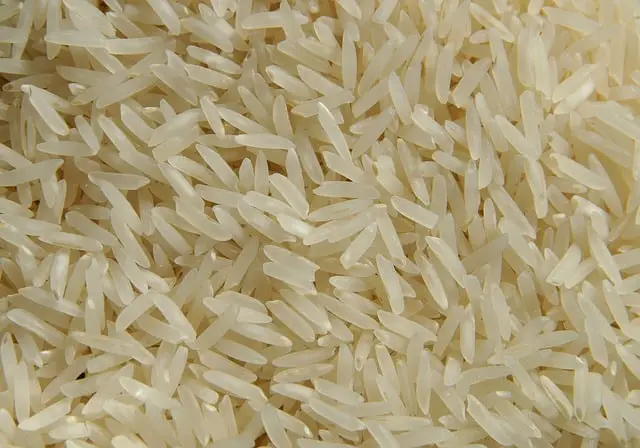Burning rice in a rice cooker is a common problem. Using the rice cooker making cooking rice easier, but it isn’t always perfect.
Sometimes despite following the directions, your rice can still end up being overcooked. Especially the bottom layer of rice in the pot, it can burn to a crisp. Rice cookers and even Instant Pots don’t always lead to perfect rice.
Here is why and what you can do about it. There are some general tips for cooking rice. No matter if you are using a rice cooker, Instant Pot or just a pot on the stove. A large part of what goes wrong starts in the prepping of the rice.
Before you cook your next batch of rice, learn a few helpful hints that will make great rice. Most importantly how to stop it from burning. I do not own a rice cooker, but I have cooked rice in a Instant Pot. The first time the bottom layer burnt pretty bad.
Luckily I was able to salvage most of the rice, but cleaning up that pot was a nightmare. I learned since how to avoid that, and luckily haven’t had bad experiences with cooking rice since.
So I hope you can use some of these tips to help you make a perfect dish of rice the next time you cook. Lets get started so you can avoid burning rice again.
So, Why does my rice burn on the bottom?
The layer of rice at the bottom burns sooner. A common reason is because there is not enough water left. The rice cooker itself continues cooking even after the water has evaporated. Instead of turning off when the water has boiled away, the cooker continues to run and starts to burn the rice.
This is usually the case with rice cookers or Instant Pots. The model of rice cooker sometimes have issues or don’t work that well. The good news is you don’t have to spend a lot on a rice cooker, higher end isn’t necessary.
Reasons for Rice To Burn: Rice Cookers and Stove Top.
There can be different levels of burn’t that happen with cooking rice. Some people like the rice to turn brown and become crispy.
This is known as scorched rice and is popular in many cultures. Scorched rice is like a crust on the bottom. To achieve that you keep your rice cooking on a low heat.
With a rice cooker just leave the rice inside while it is on warm setting. Do that for about 3 – 5 minutes.
You may be doing this by accident and it can make the pot hard to clean. Try soaking it in warm soapy water for up to an hour. This will help the cleaning process.
If you want to avoid that altogether or your rice is actually burning. As in turning black and is inedible. Then there are some methods you can try to stop this from happening.
These tips and techniques can be used for cooking rice in general. Some are geared towards rice cookers specifically. But for the most part these should help you diagnose the problem.
Rinse Rice Before Cooking: Yes or No?
Okay so I’m saying you should always rinse the rice first. Because it does depend on the type of rice. The general idea is that rinsing the rice off helps wash off excess starch. This is true for certain types of rice.
Here is a break down of types of rice and if you should rinse them off or not.
| Type of Rice | Rinse Before? |
| Short-Grain | No |
| Medium-Grain | Yes |
| long-Grain | Yes |
| Brown | Optional |
Enriched Rice vs Regular: Nutrition and Cooking Tips
White rice produced in the U.S. is enriched with nutrients and vitamins. That is because they are stripped away during the milling process. Washing them off does remove these nutrients.
It is still recommended to rinse off white rice before cooking. Talc powder has been used on rice to prevent it from sticking. It is considered safe to eat but it will wash off when you rinse the rice.
Brown rice does not need to be rinsed, but it does have bran dust on it. So some people like to wash that off before cooking.
One important part of rinsing or washing rice is to remove debris. Small rocks or dirt or even small bugs can sometimes be present. You can usually find these things if you start to rinse it off and sift through it.
Its not real common but it can happen. You can buy some rices that are pre-washed, just check the packaging to see.
Cook With More Rice
If you are using a rice cooker and the rice is burning. It could be because you are not putting enough rice in. The rice cooker should come with a measuring cup. There are designated lines inside that give indication of how much water and rice to put in.
Use the cups that go with it to get the correct amount of rice and water. Follow the preset lines that tell you at what level to fill the pot.
You may need to downsize if you do not want to cook as much rice the cooker requires.
The reason it is burning is because the ratios are off. Not enough rice and the cooker will overheat, because it does not know how much you put in. Using a smaller amount and the cooker will still run as if there is more inside to cook.
Turn Off Keep Warm Setting
One mistake you could be making is not turning the rice cooker off. After it has cooked and automatically stops. You might need to turn it off completely.
If your cooker goes into to keep warm mode, the rice will start to burn after too long. The keep warm setting is not meant to used for very long.
This as mentioned before is one way to crisp the rice. But if you are not careful it will start to burn. This will be at the bottom of the pan where the heat is coming from.
Usually rice continues to cook after it has been done. Let it steam on its own for about five minutes. If you need to keep it warm pour a little water inside. Stir it frequently as well as before leaving it sit.
Use A Better Water to Rice Ratio
Finding the right water to rice ratio is tricky. There is some debate to this as well. What is the correct rice to water ratio? well it does also depend on the type of rice.
| Type of Rice | Water Per 1 Cup of Rice |
| Short-Grain | 1 & 1/4 cups |
| Medium-Grain | 1 & 1/2 cups |
| Long-Grain | 2 or 2 1/4 cups |
| Brown | 2 cups |
Don’t Get Rice Too Hot
This can happen when you turn the heat down on your stove top. It takes some time before it will cool down. Especially with electric stoves.
Get a second burner going to use after you have reached boiling the water. Then you can move the pot over to that burner and the temperature will be less hot.
Rice cookers are designed to cook the rice at boiling temperature. They do not go any hotter. Rice cookers maintain this temperature until the water has evaporated then they stop cooking. Which is about 100 degrees C and 212 degrees F.
Don’t Lift Lid
If you remove the lid while it still cooking. The water and heat escapes too quickly. The rice is mean’t to cook with the water boiling away. Taking the lid off too soon increases the time the rice needs to cook.
If the rice starts to cook out of sync with the water ratio, it cooked be overcooked and burned. Lifting the lid frequently will interrupt the rice from cooking on its own.
Using a glass lid works best so you can see where the water is at in the pot. Use a lid that has a steam release hole. This is if you are cooking rice on your stove top.
Don’t Stir Rice
Stirring the rice is also not a good thing to do. Stirring while the rice is cooking doesn’t do anything. It can cause the rice to become mushy.
Stirring can lead to more sticking and possible burning. This is because the starches are interfered with and released more. Only stir rice that has been cooked already.
Other Tip: Fluff Rice After Cooking
You want to use a fork and fluff the rice up a bit. This is done to let any moisture trapped on the lower parts evaporate. It helps to evenly dry the rice out after cooking.
Do this about 10 minutes after cooking and when the excess steam has stopped.
It also helps the grains to break apart and separate. Any big clumps should be broken up. The grains aren’t suppose to mash up together after being cooked.


5 thoughts on “Why Your Rice Is Burning! Rice Cooker Tips and More”
Comments are closed.